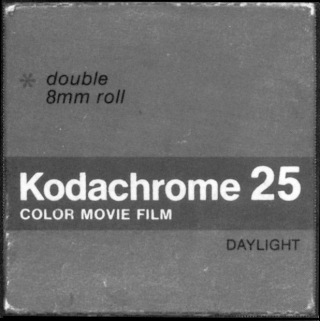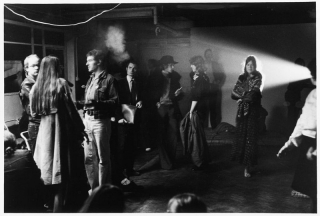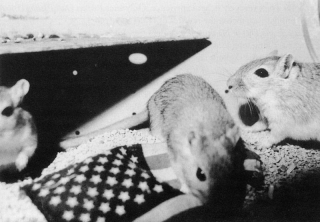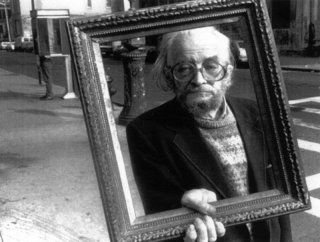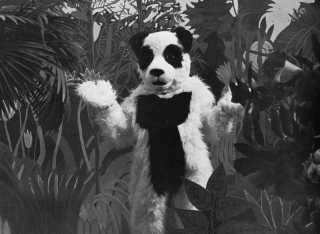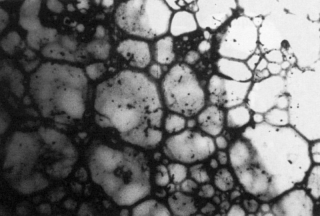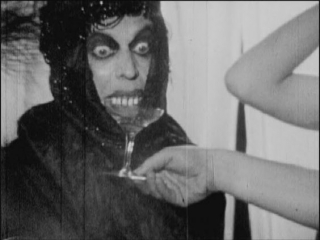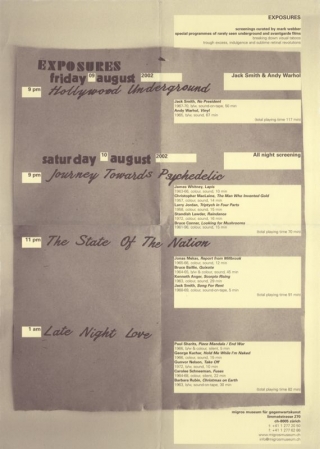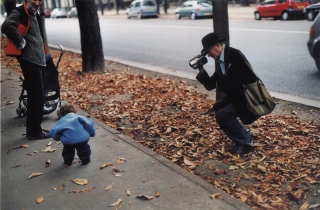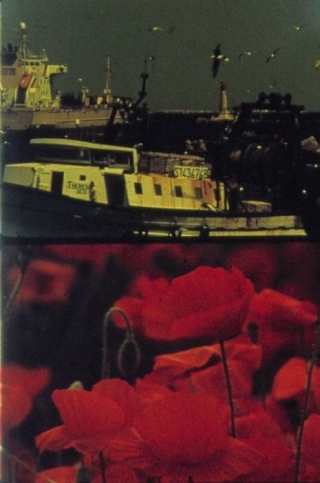Date: 29 May 2002 | Season: Infinite Projection, Shoot Shoot Shoot 2002 | Tags: Shoot Shoot Shoot
8MM FILMS FROM THE LONDON CO-OP
Wednesday 29 May 2002, at 7:30pm
London The Photographers’ Gallery
The home movie format of 8mm can empower artists to make extremely personal and direct film observations. Spontaneity and intimacy are inherent to this pocket sized system. This special evening of single and multi-screen small gauge wonders concludes Shoot Shoot Shoot, a major retrospective of British avant-garde film, which screens at Tate Modern throughout May. Many of the makers will be on hand to introduce their work.
David Crosswaite, Puddle, UK, 1968, b/w, silent, 4 min
Mike Dunford, Four Short Films, UK, 1969, b/w & colour, silent, 10 min
Mike Dunford, One Million Unemployed in Winter 1971, UK, 1971, colour, sound-on-tape, 4 min
Jeff Keen, Wail, UK, 1960, colour, silent, 5 min
Jeff Keen, Like the Time is Now, UK, 1961, colour, silent, 6 min
Malcolm Le Grice, China Tea, UK, 1965, colour, silent, 10 min
Annabel Nicolson, Black Gate, UK, 1976, colour, silent, 4 min
Sally Potter, Jerk, UK, 1969, b/w, silent, 3 min (two screen)
William Raban, Sky, UK, 1969, colour, silent, 5 min (four screen)
John Smith, Out the Back, UK, 1974, colour, silent, 4 min
David Crosswaite, Mike Dunford, Malcolm Le Grice, Sally Potter, William Raban and John Smith in attendence.
PROGRAMME NOTES
8MM FILMS FROM THE LONDON CO-OP
Wednesday 29 May 2002, at 7:30pm
London The Photographers’ Gallery
IN CELEBRATION OF 8MM
“What first attracted me to 8mm film in particular was its materiality and the way it produced tangibility problematics on all levels: the acquiring and setting up of increasingly scarce, quality projection equipment, the physicality of the sound made by the film strip running through the projector gate continuously reminds the viewer of the machine’s presence in the room, the attention to projection speed (variable fps), and the frequent act of projecting camera originals (the horror!) instead of film prints. And then there is the film itself – the sensuous texture of the projected image, the subtlety or sumptuousness of gradations in black-and-white or the discriminating use of colour, the graininess of the image (as emotionally satisfying and particular as the actual silver sparkles on 35mm nitrate stock), the unpredictability of the sound stripe, and the fragility and fleeting sense of the image’s presence on the screen. All these qualities contribute to the intimacy created between the projected films and any group able to give themselves over to the act of actually seeing.” (Jytte Jensen, Museum of Modern Art, in the exhibition catalogue “Big As Life”, 1999)
Back to top
Date: 1 June 2002 | Season: Shoot Shoot Shoot 2002 | Tags: Shoot Shoot Shoot
SHOOT SHOOT SHOOT: THE FIRST DECADE OF THE LONDON FILM-MAKERS’ COOPERATIVE & BRITISH AVANT-GARDE FILM 1966-76
June 2002–August 2002
International touring exhibition consisting of eight programmes of single-screen, double screen films and expanded cinema
May 2002 – London, UK – Tate Modern
June 2002 – Paris, France – Scratch Projections at Centre Wallonie Bruxelles / EOF Gallery
July 2002 – Brisbane, Australia – Brisbane International Film Festival / Institute for Modern Art
July 2002 – Melbourne, Australia – Melbourne International Film Festival / Experimenta / Gamma Space
September 2002 – Berlin, Germany – Arsenal / Deutsche Kinemathek
September 2002 – Karlsruhe, Germany – Kinemathek / Kamera Kunstverein
September 2002 – Frankfurt, Germany – Deutsches Filmmuseum
September 2002 – Bremen, Germany – Kino 46 / Hochschule für Künste
October 2002 – Hamburg, Germany – Metropolis Kino / Lichtmeß
November 2002 – Basel, Switzerland – Kunsthalle Basel / Stadtkino Basel
November 2002 – Barcelona, Spain – Fundació Antoni Tàpies / Hangar
November 2002 – Vitoria-Gasteiz, Spain – ARTIUM
March 2003 – New York. USA – Anthology Film Archives / Galapagos Art Space
May 2003 – Manchester, UK – Cornerhouse
May 2003 – Gateshead, UK – BALTIC / Side Cinema
March 2004 – Athens, Greece – Deste Foundation
April 2004 –Tokyo, Japan – Image Forum Festival / Hillside Gallery
May 2004 – Kyoto, Japan – Goethe Institut Kyoto
August 2004 –Seoul, Korea – 1st Seoul Experimental Film Festival
Date: 19 June 2002 | Season: Infinite Projection
TRUE PATRIOT LOVE: THE FILMS OF JOYCE WIELAND
Wednesday 19 June 2002, at 7:30pm
London The Photographers’ Gallery
In her short films, Joyce Wieland managed to distil the essence of Canadian national pride and the purest vision of a female artist. Profoundly political and inveterately sensitive, Wieland addressed the real issues from a humble perspective, but with a rigorous formality. This programme presents work seldom seen in this country, and includes the classic Rat Life and Diet in North America, which humorously depicts the plight of a group of gerbils who escape from suppression in the US to pursue an ecological future north of the border.
Joyce Wieland & Hollis Frampton, A & B in Ontario, Canada, 1967-84, b/w, sound, 17 min
Joyce Wieland, Patriotism I, Canada, 1964, colour, sound, 4 min
Joyce Wieland, Handtinting, Canada, 1967, colour, silent, 6 min
Joyce Wieland, Sailboat, Canada, 1967, colour, sound, 3 min
Joyce Wieland, Water Sark, Canada, 1966, colour, sound, 14 min
Joyce Wieland, Patriotism II, Canada, 1965, colour, silent, 3 min
Joyce Wieland, Peggy’s Blues Skylight, Canada, 1965, b/w, sound, 11 min
Joyce Wieland, Rat Life and Diet in North America, Canada, 1968, colour, sound, 14 min
Joyce Wieland, Birds at Sunrise, Canada, 1972-86, colour, sound, 10 min
“Joyce Wieland’s films elude easy categorisation. The body of work as a whole is varied – some of a formal nature, others less so. Several are political, concerned with technology, ecology and her native land, Canada. Her films are informed by her involvement in other, more directly tactile art forms – painting, drawing, construction, and work derived from quilting, such as stuffed wall hangings, pillowed quilts and embroidery. There is always a concern with textures and/or colours and their relationships within the frame and within the shaping of each film as a whole. Moreover, there is an ongoing dialogue, a cross-fertilisation between film and the other forms of art in which she works.” (Regina Cornwell, 1971, reprinted in The Films of Joyce Wieland (ed. Kathryn Elder), 1999)
Back to top
Date: 3 July 2002 | Season: Infinite Projection
HARRY SMITH: AMERICAN MAGUS
Wednesday 3 July 2002, at 7:30pm
London The Photographers’ Gallery
A documentary by Paola Igliori (editor of an indispensable book with the same title) which provides a fascinating insight into the life and work of singular genius Harry Smith, whose pioneering abstract films were only a small part of his anthropological pursuits. His broad range of interests, including alchemy, the occult, folk music, field recordings, Seminole textiles and Ukranian Easter Eggs, are represented in this suitably kaleidoscopic film which flits between mysticism and secularity.
Paola Igliori, American Magus, Italy/USA, 2002, video, colour, sound, 93 min
PROGRAMME NOTES
HARRY SMITH: AMERICAN MAGUS
Wednesday 3 July 2002, at 7:30pm
London The Photographers’ Gallery
AMERICAN MAGUS
Paola Igliori, Italy/USA, 2002, video, colour, sound, 93 min
(UK premiere)
“It took a little time, but now at last a full length documentary has been made about the cult figure Harry Smith, one of the hidden jewels of the intellectual and artistic history of America in the 20th century. Smith became known to a certain extent with his Anthology of American Folk Music in 1952, but his brilliant spirit and versatility extended much further. In 1950, he received a Guggenheim grant for his non-objective films and paintings, as anthropologist he was interested in anything from peyote to string figures. He was a revolutionary collector looking for the synchronous patterns in different kinds of objects to find their inner language and he was one of the most grisly and erudite occultists ever.
“Filmmaker and poet Paola Igliori, who had an intense relationship with Smith in the last months of his life, uses interviews with Allen Ginsberg, Robert Frank, Jonas Mekas and others, and pictures from his films, his countless collections, synthetic diagrams and rare archive material, to sketch a fascinating portrait of the man who influenced artists from Gregory Corso to DJ Spooky, and of whom was said that he lived a thousand lives in one. Or, to quote one of the many eloquent statements: “Without Harry Smith I wouldn’t have existed!” (Bob Dylan).”
(Catalogue of the International Film Festival Rotterdam, 2002)
Back to top
Date: 17 July 2002 | Season: Infinite Projection
THE FILM ACCORDING TO OWEN LAND (FORMERLY KNOWN AS CINEMA ACCORDING TO GEORGE LANDOW)
Wednesday 17 July 2002, at 7:30pm
London The Photographers’ Gallery
Ranging from the celebrated early structural films through to the post-modern and referential works which combine/confuse humour with dense theoretics, here are the incredible works of cinema’s mystery man Land(ow) (including the rarely screened original version of Institutional Quality). He exposed the material of film, deconstructed the process and the effect, while covering the ‘big topics’ of religion, psychoanalysis, capitalism and pandas making avant-garde movies. Last reported to be making a feature length revisionist history of underground film on 35mm.
Owen Land, Diploteratology or Bardo Follies, USA, 1967, silent, colour, 20 min (full version)
Owen Land, The Film that Rises to the Surface of Clarified Butter, USA, 1968, b/w, sound, 10 min
Owen Land, Institutional Quality, USA, 1969, colour, sound, 5 min (original version)
Owen Land, Wide Angle Saxon, USA, 1974, colour, sound, 22 min
Owen Land, “No Sir, Orison”, USA, 1975, colour, sound, 3 min
Owen Land, Thank You Jesus for the Eternal Present: 1, USA, 1973, colour, sound, 6 min
Owen Land, A Film of Their 1973 Spring Tour Commissioned by Christian World Liberation Front of Berkeley, California, USA, 1974, b/w, sound, 11 min
Owen Land, On the Marriage Broker Joke as cited by Sigmund Freud in Wit and its Relation to the Unconscious, or Can the Avant-Garde Artist Be Wholed?, USA, 1980, sound, colour, 18 min
PROGRAMME NOTES
THE FILM ACCORDING TO OWEN LAND (FORMERLY KNOWN AS CINEMA ACCORDING TO GEORGE LANDOW)
Wednesday 17 July 2002, at 7:30pm
London The Photographers’ Gallery
“My films are not intended as entertainment or easy viewing. They do not attempt to engage the spectator on an emotional level. Therefore audience reactions are unpredictable, especially during Diploteratology or Bardo Follies. A showing for the wring type of audience could be commercially disastrous, though not necessarily without benefit.” (Owen Land (formerly known as George Landow), Film-Makers Lecture Bureau Catalogue No.1, 1969)
“Since the late 1960s, the films of Owen Land (formerly known as George Landow) have punctured education’s pretensions and avant-garde premises and styles. His work stands comically against disciplines – artistic and pedagogic. The wry humorist deflates current fashion – avant-garde film tenets, audiences, student films, psychoanalysis and structural film. In many ways, all of his works, including performance and then video, are critiques of avant-garde practises. Land uses the stuff of education, including the arbitrary pleasures of language’s puns and sounds, to marshal his attack on the lunacy of disciplines. His films depict simulations of simulations of ‘real’ life that become increasingly fantastic and elaborate. Land’s work is a playful theory of comedy and a compendium of the sound-image-audience triangle. His films address art with forms of popular culture, recycling old formulas into critique, of commodity culture and art, without the ponderous baggage of moral condemnation.” (Patricia Mellancamp, extracts from “Indiscretions: Avant-garde Film, Video & Feminism”, 1990)
Back to top
Date: 31 July 2002 | Season: Infinite Projection
THE BASQUE MASTERPIECE
Wednesday 31 July 2002, at 7:30pm
London The Photographers’ Gallery
Ere Erera Baleibu Icik Subua Aruaren traverses infinite dimensions in its abstract, cinemascopic passage. This epic voyage was hand painted onto 35mm by the Spanish artist José Antonio Sistiaga, and his collaborators, over an eight-month period in 1970. The film’s continually changing chromatic structures almost caused riots at early screenings, but it is now widely regarded as an exemplary achievement of moving visual music and spiritual devotion.
José Antonio Sistiaga, Ere Erera Baleibu Icik Subua Aruaren, 1970, 75 min (Cinemascope)
PROGRAMME NOTES
THE BASQUE MASTERPIECE
Wednesday 31 July 2002, at 7:30pm
London The Photographers’ Gallery
ERE ERERA BALEIBU ICIK SUBUA ARUAREN
José Antonio Sistiaga, Spain, 1970, 16mm, colour, silent, 75 min (Cinemascope)
“A rare screening of the cameraless, hand-painted, abstract epic commonly referred to as The Basque Masterpiece. José Antonio Sistiaga (born 1932 in Saint-Sébastien) began his career as a painter. He was responsible for founding the Gaur group of Basque artists, who conducted research in style and studied the connection between education and art. After his three-part experimental film (his first foray into filmmaking) won an award at the Bilbao festival, he expanded the final section into a feature. More orchestral in form than a Brakhage hand-painted film, Sistiaga’s modulates gradually through monochromatic movements which build to a vibrant multi-coloured finale.” (Cinematheque Ontario programme notes, 2002)
“Believe it or not, all 75 minutes are fascinating, with a cumulative satisfaction.” (Dr. William Moritz)
Back to top
Date: 9 August 2002 | Season: Exposures
SUBLIME SUBVERSION
Friday 9 August 2002, at 9pm
Zurich Migros Museum für Gegenwartskunst
The opening night of a sequence of screenings presented in relation to the St. Petrischnee exhibition at the Migros Museum für Gegenwartskunst, Zürich.
Jack Smith, No President, USA, 1967-70, b/w, sound-on-tape, 50 min
Andy Warhol, Vinyl, USA, 1965, b/w, sound, 66 min
Back to top
Date: 10 August 2002 | Season: Exposures
ALL NIGHT SCREENING
Saturday 10 August 2002, at 9pm / 11pm / 1am
Zurich Migros Museum für Gegenwartskunst
A late-night sequence of screenings presented in relation to the St. Petrischnee exhibition at the Migros Museum für Gegenwartskunst, Zürich.
JOURNEY TOWARDS PSYCHEDELIC
James Whitney, Lapis, 1963-66, colour, sound, 10 min
Christopher MacLaine, The Man Who Invented Gold, 1957, colour, sound, 14 min
Larry Jordan, Triptych in Four Parts, 1958, colour, sound, 15 min
Standish Lawder, Raindance, 1972, colour, sound, 16 min
Bruce Conner, Looking for Mushrooms, 1961-96, colour, sound, 15 min
THE STATE OF THE NATION
Jonas Mekas, Report from Millbrook, 1965-66, colour, sound, 12 min
Bruce Baillie, Quixote, 1964-65, b/w & colour, sound, 45 min
Kenneth Anger, Scorpio Rising, 1963, colour, sound, 29 min
Jack Smith, Song For Rent, 1968-69, colour, sound-on-tape, 5 min
LATE NIGHT LOVE
Paul Sharits, Piece Mandala / End War, 1966, b/w & colour, silent, 5 min
George Kuchar, Hold Me While I’m Naked, 1966, colour, sound, 15 min
Gunvor Nelson, Take Off, 1972, b/w, sound, 10 min
Carolee Schneeman, Fuses, 1964-68, colour, silent, 22 min
Barbara Rubin, Christmas on Earth, 1963, b/w, sound-on-tape, 30 min (2 screen)
Back to top
Date: 21 August 2002 | Season: Infinite Projection | Tags: Jonas Mekas
JONAS MEKAS VIDEO SHOW
Wednesday 21 August 2002, at 7:30pm
London The Photographers’ Gallery
A rare opportunity to view videotapes by the legendary advocate of avant-garde film. His organisation Anthology Film Archives began to show videotapes by artists as early as 1974, and Mekas himself has been regularly using video since the mid-1980s, amassing footage and creating tapes which are largely unknown or unseen. Jonas Mekas will be in the UK for a retrospective at the Edinburgh Film Festival, and will join us to introduce this screening.
Jonas Mekas, Self-Portrait, 1980, 11 min
Jonas Mekas, Remedy for Melancholy, 1993-97, 28 min
Jonas Mekas, Autobiography of a Man Who Carried his Memory in his Eyes, 2000, 50 min
Jonas Mekas, Cinema is Not 100 Years Old, 1996, 5 min
“I got into video when a New York Sony representative decided to hand for free Sony 8 video cameras to ‘famous’ New Yorkers in exchange for a few minutes of video they would use then to promote the cameras. So I got one, and gave them my first very, very bad five minutes of video. They also gave one camera to Allen Ginsberg, who took it on his trip to Israel where it was stolen from him; Sony got no footage. Anyway, that was the beginning.
“That was in late 1987. The camera was Video 8. Later I switched to Video Hi-8, and that’s where I still am. Because I like to do all my editing at home and at weirdest and unpredictable hours, I cannot yet afford digital video due to the expensive editing equipment. But Hi-8 editing is cheap.
“Jokingly I say, when asked, that I use the video camera as I would use a tape recorder. There is some truth to it. It’s opposite to what I do with my Bolex. No single frames. No emphasis on colour. It’s more stress on mood, atmosphere, and you can’t get mood or atmosphere in single frames. Which means, in my video diaries I record a different aspect of reality than what I do with a Bolex or in my written poetry.
“I have collected by now, that is, by June 1st, 2002, c.750 hours of video material. During the next 12 months or so my intention is to prepare a c.24 hour video volume of my life in New York.”
(Jonas Mekas, 1st June 2002)
PROGRAMME NOTES
JONAS MEKAS VIDEO SHOW
Wednesday 21 August 2002, at 7:30pm
London The Photographers’ Gallery
SELF-PORTRAIT
Jonas Mekas, USA, 1980, colour, sound, 11 min
One twenty minute take, a soliloquy, myself talking about myself. Taped in collaboration with Robert Schoenbaum, at the house / porch of Sally Dixon, St. Paul.
REMEDY FOR MELANCHOLY
Jonas Mekas, USA, 1993-97, colour, sound, 28 min
Includes four sketches: With Peter Kubelka at St. Michel; our cat Apache and Nina Hagen; children of the School for Violin; the books of Ken Jacobs.
AUTOBIOGRAPHY OF A MAN WHO CARRIED HIS MEMORY IN HIS EYES
Jonas Mekas, USA, 2000, colour, sound, 50 min
A condensed survey of my first 50 years in New York – physically and mentally.
CINEMA IS NOT 100 YEARS OLD
Jonas Mekas, USA, 1996, colour, sound, 5 min
The true history of the cinema is the hidden history of friends who meet to do what they love. For us the cinema starts with each humming of projector, with each new buzz of our camera, our hearts are projected forwards. My friends, cinema is not yet 100 years old.
We appreciate the help of Louis Benassi and the Edinburgh Film Festival in making this event possible. Thanks also to Jane Giles.
Back to top
Date: 4 September 2002 | Season: Infinite Projection
PIP CHODOROV AND THE SPOOLS OF PARIS
Wednesday 4 September 2002, at 7:30pm
London The Photographers’ Gallery
Pip Chodorov, filmmaker and director of the video label Re:Voir will present his selection of recent films from France and report on the Paris scene, which is alive with active publishers, distributors, screenings and independent groups. The programme will feature work made at L’Abominable and MTK, two collective laboratories, and includes films by Frédérique Devaux, Rose Lowder and Nicolas Rey.
Pip Chodorov, Numéro 4, France, 1990, colour, sound, 4 min (18fps)
Mahine Rouhi, Ptkho, France, 2000, b/w, sound, 7 min
Stefano Canapa, Promenaux, France, 2001, b/w, sound, 6 min
Colas Ricard, Tandem, France, 2001, colour, sound, 6 min
Nicolas Rey, Terminus for You, France, 1996, b/w, sound, 9 min
Marcelle Thirache, L’Arbre Bleu, France, 2001, colour, silent, 4 min (18fps)
Frédérique Devaux, Logomagie, France, 1999, colour, sound, 4 min
Rose Lowder, Les Coquelicots, France, 2000, colour, silent, 3 min (18fps)
Othello Vilgarde, Terrae, France, 2001, b/w, sound, 10 min
Dominik Lange, Chrysalides en explosion, France, 2001, colour, sound-on-cd, 17 min
“In these new lyric works and optical printer films, contemporary filmmakers continue to walk through the world and report what they see, and how they see. As Pthko shows us, some of the films are misleadingly abstract. Promenaux takes us through Paris, its jazz, its streets, its train tracks. In Tandem, train tracks become a metaphor for the film strip. Terminus for You continues the analogy in the Paris metro, its moving sidewalks, its regularly spaced posters and its animated characters carrying the metaphor, until the decomposition of the film material itself reminds us that all is illusory, all is grain and light. Terminus For You, L’Arbre Bleu and Logomagie are all worked by hand on the emulsion, whereas Numéro 4 and the last three films, Poppies, Terrae and Chrysalides use the movie camera as a still camera, flickering between different stills of natural forms, proving once again that movement is not created in the film but in the brain.” (Pip Chodorov, 2002)
Back to top
